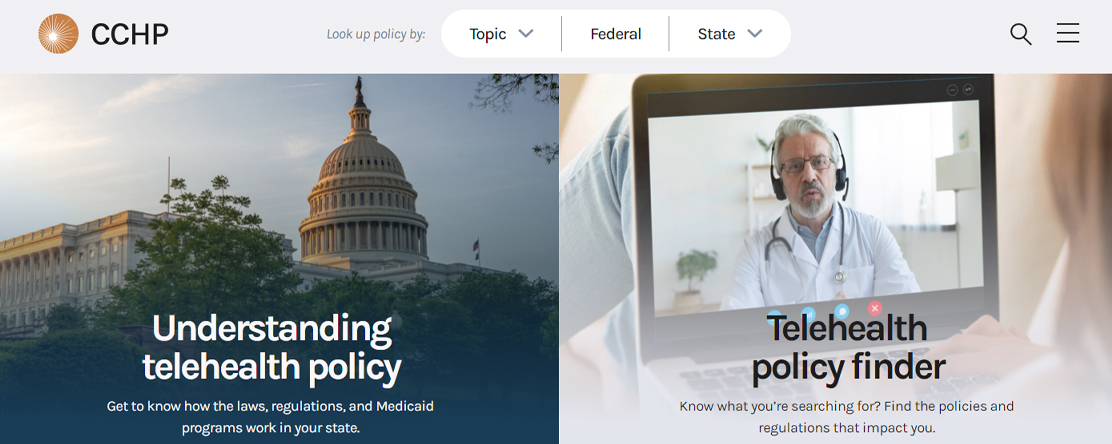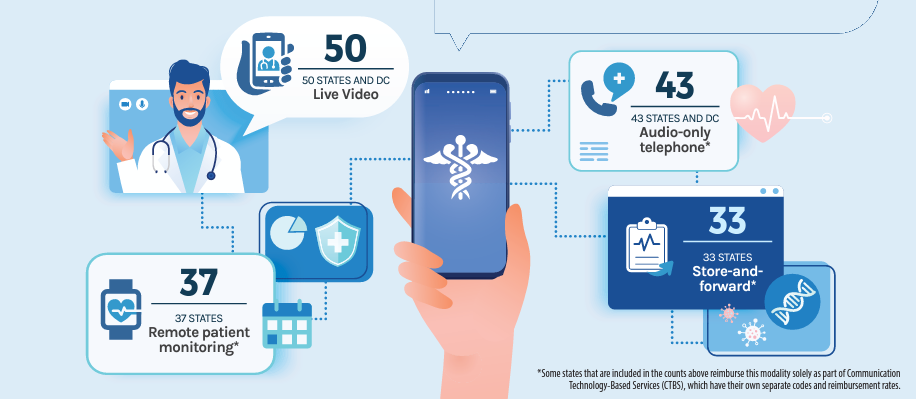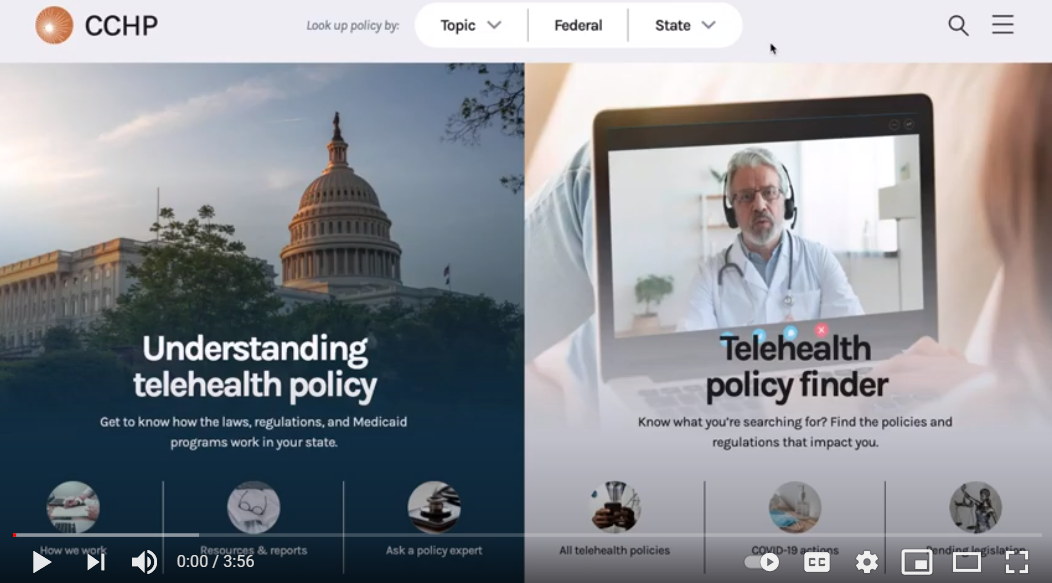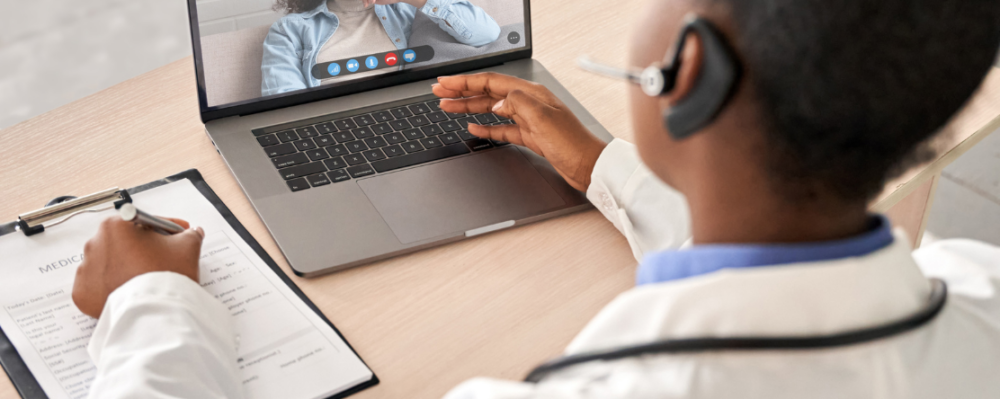
Tool: Telehealth Policy Finder
-
Focus Areas
Data, Technology & Innovation -
Issues
Technology & Telehealth -
Programs
Center for Connected Health Policy

Across the country, no two states are alike in how they define and regulate telehealth. To help policymakers, health advocates and other health care professionals understand the policies and trends throughout the nation, the Telehealth Policy Finder tool compiles telehealth-related laws and regulations across all 50 states and the District of Columbia, as well as at the federal level.
Explore the Policy Finder tool
Spring 2024 Telehealth Policies and Federally Qualified Health Centers Fact Sheet
Supported through funding from the National Association of Community Health Centers (NACHC), in the Fall of 2022 the Center for Connected Health Policy’s (CCHP) Policy Finder tool and accompanying telehealth summary report began including a new category dedicated to telehealth Medicaid fee-forservice policies for federally qualified health centers (FQHCs). Since then, CCHP has continued to maintain the FQHC category in its policy finder. View the fact sheet to find updated information and examples of policy trends for Spring 2024.

Latest Policy Developments in CCHP’s Telehealth Policy Finder and Policy Trends Map (Updated 6/12/2024)
•ALABAMA: Amended a rule prohibiting physicians from utilizing any form of telemedicine when certifying or recommending, or recertifying or re-recommending, a patient for the use of medical cannabis, or when conducting any examination associated with medical cannabis.
•ALASKA: Alaska Medicaid released a new Frequently Asked Questions (FAQ) document for tribal federally qualified health centers (FQHCs) which clarifies that tribal FQHCs should defer to Alaska Medicaid’s current guidance on telehealth as well as their Telehealth Coverage FAQs document for information on telemedicine, telephonic and store and forward telehealth services. In response to the question around whether a tribal FQHC can provide services off-site after February 11, 2025, the Tribal FQHC FAQ directs providers to a regulation adopted in 2023 which allows the provision of services via telehealth.
•CALIFORNIA: The Department of Health Care Services (DHCS) in California issued a notice that specifies that clinically appropriate telehealth may be considered in determining compliance with network adequacy standards and for purposes of approving an alternative access standard (AAS) request, however behavioral health plans (BHPs) cannot require a member to access services via telehealth only. DHCS also issued a news alert retroactively allowing certain codes 99402-99403 (preventive medicine counseling and/or risk factor reduction intervention) to be reimbursed within the Local Educational Agency Billing Option Program under the state’s Medicaid program (Medi-Cal), including via telehealth when using the modifier 95. In addition, SB 233 was enacted to authorize Arizona physicians to treat Arizona patients in CA, specific to abortion care and registration with the applicable state board, but only through November 30, 2024.
•DISTRICT OF COLUMBIA: Passed B 25-0545 which includes a section on telehealth stating that health professionals may provide telehealth services consistent with the standard of care. It also specifies that that a practitioner-patient relationship can be established through telehealth, though additional requirements for specific health professions may apply including a need for an initial in-person physical exam. The new law also clarifies that a license from the District of Columbia is necessary unless the client or patient is temporarily present in the District or they are a resident and the services provided do not exceed 120 days or a longer period of time as determined by the mayor.
•FLORIDA: Passed House Bill 855 which requires that any advertisement for dental services provided through telehealth include the statement that “An in-person examination with a dentist licensed under chapter 466, Florida Statutes, is recommended before beginning telehealth treatment in order to prevent injury or harm.” The new law also lists the specific dental services this statement applies to (such as digital scanning, denture repair, etc.). Florida also joined the Interstate Medical Licensure Compact and the Audiology and Speech Language Pathology Interstate Compact.
•HAWAII: Hawaii Medicaid updated their Provider Manual’s chapter on Dental Services, specifying that clinics that qualify for FQHC Prospective Payment System (PPS) reimbursement may submit telehealth claims using PPS reimbursement, as long as both the patient and dentist were each physically located at separate eligible FQHC/RHC sites during the encounter and the diagnosis. Claims for patients that were located at “public health settings” not federally registered as a FQHC or RHC service site are not eligible for PPS reimbursement. Additional clarification was also provided for how radiographic services using asynchronous technology should be billed (see manual). A new statutory allowance was also found that allows the Board of Dentistry to issue a temporary license without an examination to a qualified resident nonresident who is under contract with the state, county or legally incorporated eleemosynary dispensary or infirmary, private school, or welfare center. The temporary license authorizes the practice of dentistry exclusively while engaged in the employment of one the entities previously mentioned or contracted by the department of health to conduct dental education and training.
•KANSAS: The KS Medical Assistance Program (KMAP) updated the General Benefits section of their provider manual in May to specify that services provided through telemedicine must be medically necessary and are subject to the terms and conditions of the individual’s health benefits plan. KMAP cannot require a covered individual to use telemedicine in lieu of receiving an in-person healthcare service or consultation from an in-network provider. It also adds that nothing in the Kansas Telemedicine Act authorizes the delivery of any abortion procedure via telemedicine.
•LOUISIANA: The Louisiana Department of Health and Hospitals updated their Behavioral Health Services Manual to indicate that group psychotherapy is only allowed via telehealth when utilized for Dialectical Behavioral Therapy (DBT) and must include synchronous, interactive, real-time electronic communication comprising of both audio and visual elements.
•MINNESOTA: Passed Senate File 3567 which requires that beginning October 1, 2024, to the extent space is available, a school district or charter school must provide an enrolled secondary school student with access during regular school hours, and to the extent staff is available, before or after the school day on days when students receive instruction at school, to space at the school site that a student may use to receive mental health care through telehealth from a student's licensed mental health provider. See the full text of the bill for additional requirements for the dedicated space. Additionally, new sections on telehealth were added to the Abortion and Reproductive Health Services Manual. Minnesota also joined the Audiology and Speech Language Pathology Interstate Compact, the Counseling Compact, the Physician Assistant Compact and the Social Work Compact.
•MONTANA: Amended a rule which applies to physicians and physician assistants that previously required an in-person examination before the prescribing of Schedule II controlled substances could occur. The rule was changed to now only specify that licensees must ensure they must comply with the Drug Enforcement Agency (DEA) requirements for controlled substances (see second article in this newsletter) and MT Code Sec. 37-20-404.
•NEW MEXICO: New Mexico Medicaid issued a supplement document on the implementation of mobile crisis intervention services and mobile response and stabilization. The Supplement specifies that multidisciplinary mobile crisis teams (MCTs) can conduct screenings and assessments within their permitted scope of practice via telehealth. New Mexico also amended their administrative code related to aesthetic healthcare facilities to indicate that telemedicine may be used by an advanced practice registered nurse (APRN) or other licensed independent healthcare provider for assessment and face-to-face examinations provided that such use complies with any applicable state and federal law and that the quality of the video examination does not adversely affect the face-to-face assessment or diagnosis.
•NEW YORK: Passed Senate Bill 8307 which extends the date that telehealth reimbursement parity is required for private payers in the state from April 1, 2024 to April 1, 2026. New York Medicaid also released a Telehealth Provider Manual providing a central place for fee for service Medicaid providers to find information on telehealth reimbursement. New York Medicaid also issued a Provider Update stipulating that perinatal doula services can be administered in-person and via telehealth in accordance with the state’s telehealth policy coverage. The same Provider Update also addresses the “Eligible Threshold Visit” for federally qualified health centers and rural health clinics, and specifies that an eligible threshold visit can occur either in person or via telehealth if it’s medically necessary and rendered by a qualifying practitioner.
•NORTH DAKOTA: North Dakota Medicaid updated their telehealth policy to include reimbursement for interprofessional Telephone/Internet/EHR Consultations.
•OHIO: Updated their administrative code pertaining to requirements around forming a bona fide physician-patient relationship that allows for the prescribing of medical marijuana. The update specifies that the examination to establish such a relationship can either be in-person or through the use of telehealth services as long as the physician will provide care to the patient on an ongoing basis.
•OKLAHOMA: Oklahoma joined the Physician Assistant Compact.
•UTAH:Passed Senate Bill 24 which adds physician assistants to a provision of law requiring Medicaid reimbursement for telepsychiatric consultations. Utah also joined the Social Work Compact.
•VERMONT: Vermont joined the Occupational Therapy Compact and the Social Work Compact.
Fall 2023 Updates
During their Fall review, CCHP noted that many state Medicaid programs moved to add a range of specific services as reimbursable when delivered via telehealth as well as additional provider types that can serve as distant site providers. For instance, Nebraska Medicaid released guidance incorporating many PHE policies into their permanent reimbursement policies. This includes reimbursement for services such as health check services, mental health and substance use, physical and occupational therapy, physician services, speech pathology and audiology, visual care, and chiropractic services. Moreover, various Medicaid programs have adopted strategies reminiscent of Medicare, detailing eligible telehealth service codes in a list for providers to reference, with some states identifying a subset of the codes as suitable for audio-only interactions. Likewise, many states have also now adopted the place of service (POS) code system previously introduced by Medicare, where POS 10 indicates services provided at a patient’s home and 02 indicates telehealth services provided at an originating site other than the patient’s home.
Just as in previous issues of this Summary Report, since the onset of the COVID-19 PHE, state Medicaid programs continue to expand their audio-only reimbursement policies. However, the transition to permanent policy changes has typically been characterized by a more deliberate and cautious approach compared to the rapid implementation of temporary measures during the COVID-19 pandemic. North Dakota’s General Information Provider Manual was updated, for instance, to provide for reimbursement of audio-only telephone evaluation and management (E/M) services, but only when initiated by an established patient or guardian of an established patient. In June, Vermont Medicaid issued a Banner Notice related to their coverage of audio-only services, announcing that they will continue to allow audio-only services for a defined list of codes, which mirrors the Medicare list of codes. In addition to audio-only telephone, a limited number of states are expanding into other modalities including store-and-forward and remote patient monitoring. For example, Utah provides reimbursement for interprofessional internet assessment and management services for psychiatrists, which are listed as covered in their provider manual. Meanwhile, Texas passed HB 2727 which amends the statute related to its home telemonitoring services to modify the program to allow FQHCs and RHCs to be eligible providers. It also adds end stage renal disease or a condition that requires renal dialysis treatment to the list of eligible conditions for remote telemonitoring services, among other changes.
Policies addressing requirements for provider enrollment, including rules around an in-state address, is the newest phenomenon in Medicaid telehealth policy. Alabama’s Telemedicine Policy, for instance, now requires an in-state or qualifying bordering state site of practice address from which telemedicine services can be provided. In some states, this has become such an issue that it necessitated legislation (for example, Indiana’s HB 1352), forbidding Medicaid programs from requiring an in-state address or provider’s presence for Medicaid enrollment.
Read the full Fall 2023 report, and explore the state summary chart showing where states stand on many key telehealth policies, as well as an infographic highlighting key findings.
Additional findings:
- Fifty States and Washington DC provide reimbursement for some form of LIVE VIDEO in Medicaid fee-for-service. Both the jurisdictions of Puerto Rico and Virgin Islands do not explicitly indicate they reimburse for live video in their permanent Medicaid policies.
- Thirty-three state Medicaid programs reimburse for STORE-AND-FORWARD. Florida, Montana, North Dakota, South Carolina and Utah are the states which added reimbursement for store and forward, although each in a limited capacity, and some only through specific communication technology-based service (CTBS) codes since the Spring update.
- Thirty-seven state Medicaid programs provide reimbursement for REMOTE PATIENT MONITORING (RPM). Three states, (Florida, Idaho, and Iowa) added reimbursement for RPM since Spring 2023.
- Forty-three states and DC Medicaid programs reimburse for AUDIO-ONLY telephone in some capacity; however, often with limitations. Seven states including Alabama, Idaho, Kansas, Montana, Nebraska, Oklahoma, and Vermont added reimbursement for audio-only telehealth in some capacity since Spring 2023.
- Twenty-five state Medicaid programs including Alaska, Arizona, California, Hawaii, Illinois, Iowa, Kentucky, Maine, Massachusetts, Maryland, Michigan, Minnesota, Missouri, New York, North Carolina, North Dakota, Ohio, Oregon, South Carolina, Texas, Utah, Vermont, Virginia, Washington, and Wisconsin reimburse for ALL FOUR MODALITIES (live video, store-and-forward, remote patient monitoring and audio-only), although certain limitations may apply.
- Forty-three states, the District of Columbia and Virgin Islands have a PRIVATE PAYER LAW that addresses telehealth reimbursement. Not all of these laws require reimbursement or payment parity. Twenty-four states have explicit payment parity. No new states have added a private payer law since Spring 2023, though a few states have made modifications to private payer law requirements.
- Thirty-six states and DC explicitly allow FQHCs to serve as originating sites and thirty-seven states and DC explicitly allow FQHCs to serve as distant sites for telehealth. Meanwhile, twenty-five state Medicaid programs and DC explicitly clarify that FQHCs are eligible for the prospective payment system (PPS) rate when serving as distant sites.

Getting started with the Policy Finder
Launched in Spring 2021 by PHI’s Center for Connected Health Policy (CCHP), the Policy Finder tool is a searchable, easy-to-use database that is updated consistently throughout the year. Formerly known as the State Telehealth Laws and Reimbursement Report, the information from the online database can be exported for each state into a PDF document using the most current information available on CCHP’s website.
Use the Policy Finder tool to:
- Look up telehealth-related laws and regulations by topic, including COVID-19, Medicaid & Medicare, Private Payer and Professional Requirements
- Explore all current laws, temporary COVID-19 actions, and pending legislation in all 50 states and the District of Columbia, as well as at the federal level
- Compare the policy of any of the topic areas for any two states
- View color-coded maps recapping policy trends by state across topic areas, including Medicaid reimbursement for live video, store and forward and remote patient monitoring
The Policy Finder is designed to provide timely policy information that is easy for users to navigate and understand. Watch a quick tutorial to explore the tool, see how to use it and learn about its features:
Please note: this information should not be construed as legal counsel. Consult with an attorney if you are seeking a legal opinion.
Originally published by Center for Connected Health Policy
Work With Us
You change the world. We do the rest. Explore fiscal sponsorship at PHI.
Support Us
Together, we can accelerate our response to public health’s most critical issues.
Find Employment
Begin your career at the Public Health Institute.



